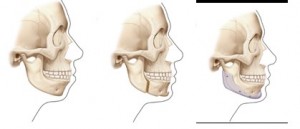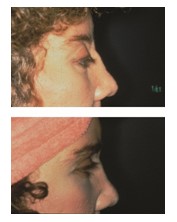Who are candidates for facial implants?
Patients with normal, deficient, and surgically altered or traumatically deformed anatomy may all benefit from implant augmentation of their craniofacial skeleton.
Most often, facial skeletal augmentation is done to enhance facial appearance in patients whose skeletal relationships are considered within the normal range. They want more definition and angularity to their appearance. Other patients desire to†balance†their facial dimensions. to balance her profile.
Craniofacial deformities which are disfiguring and are of functional consequence to vision, breathing, and eating, usually require skeletal osteotomies and rearrangement as treatment. Less severe midface and mandibular hypoplasia are common facial skeletal variants. In patients with these morphologies, occlusion is normal or has been compensated by orthodontics. These patients have neither breathing nor visual compromise. In skeletally deficient patients whose occlusion is normal or has been previously normalized by orthodontics, skeletal repositioning would necessitate additional orthodontic tooth movement. Such a treatment plan is time consuming, costly, and potentially morbid. It is, therefore, appealing to few patients. In these patients, the appearance of skeletal osteotomies and rearrangements can be simulated through the use of facial implants. Diagrammatic representations of how implant surgery can mimic the appearance of skeletal osteotomies are shown below. Note the deficient mandible on the far left. The center image shows how the profile improves after sagittal split and sliding genioplasty. The figure on the right shows that a similar contour can be obtained with implants.
Patients with craniofacial syndrome microforms and those with previously corrected syndromic deficiencies can often benefit from implant augmentation. The figure below shows a woman with Stickler’s syndrome who had undergone monobloc facial advancement surgery as a child.  Forehead contour and supraorbital rim-globe relationships were improved with an acrylic onlaycranioplasty.
Post-traumatic and post-ablative deformities may also benefit from alloplastic implant reconstruction.
Alloplastic implants can improve or restore facial skeletal contour when implant dimensions are appropriate and when they are properly positioned beneath healthy soft tissues.



Leave Comments
You must be logged in to post a comment.